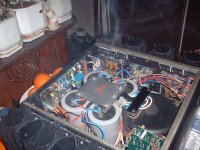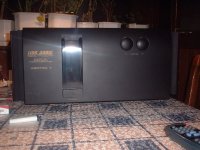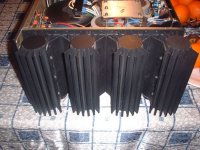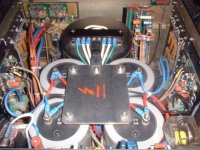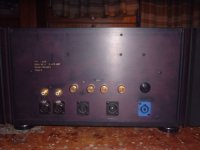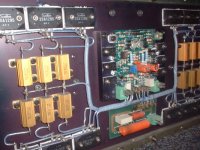Re-Cycled Dynaco Chassis - Headphone Amp.
Here is an old Dynaco PAT-4 preamp. chassis that was gutted and the electronics for a headphone amp. were installed. Since I recently purchased a pair of Sennheiser HD-580 headphones, I decided I needed a good dedicated amp to drive them. The amp is the AMB Beta 18, which is basically the the most recent Ti Kan upgrade from the SDS Labs amp..
http://www.ibiblio.org/tkan/audio/beta18.html
BB opa2134 running in class A mode driving a Mosfet pair. LM317-337 power supply. This unit will drive any headphone load loud and cleanly!
Everything was hard wired to perf boards.
All The Pics:
http://s76.photobucket.com/albums/j7/A1095US/Beta18 Headphone Amp/
Here is an old Dynaco PAT-4 preamp. chassis that was gutted and the electronics for a headphone amp. were installed. Since I recently purchased a pair of Sennheiser HD-580 headphones, I decided I needed a good dedicated amp to drive them. The amp is the AMB Beta 18, which is basically the the most recent Ti Kan upgrade from the SDS Labs amp..
http://www.ibiblio.org/tkan/audio/beta18.html
BB opa2134 running in class A mode driving a Mosfet pair. LM317-337 power supply. This unit will drive any headphone load loud and cleanly!
Everything was hard wired to perf boards.
An externally hosted image should be here but it was not working when we last tested it.
All The Pics:
http://s76.photobucket.com/albums/j7/A1095US/Beta18 Headphone Amp/
Zen Audio Headphone Amplifier
Hello , my new Zen headphone amplifier project by Marcello Pellerano
Hello , my new Zen headphone amplifier project by Marcello Pellerano
An externally hosted image should be here but it was not working when we last tested it.
http://i10.tinypic.com/4zayekj.jpg and http://i9.tinypic.com/673stgh.jpg from www.headwize.com 😎My â22 headphone amp and ó22 PSU
My Beta22 headphone amplifier is built as 3-channel active-ground configuration and is housed in an ATI-737U enclosure.
The Beta22 boards are mounted on a backplane board to reduce wirings and keep the internal of the amp tidy.
All electrolytic capacitors used on the amplifier boards are Black Gate Std. and the small values capacitors are MKT, MKP and polystyrene. All BJT’s are matched within 5% .
Manganin 1% power resistors (type PBH) are used at the output while Vishay-Dale RN55D resistors are used on the remaining part of the amp.
The volume control is an Alps RK40 "black beauty".

More pics here:
http://i72.photobucket.com/albums/i161/Ferrari_01/DIY/Beta/Afbeelding244-1.jpg
http://i72.photobucket.com/albums/i161/Ferrari_01/DIY/Beta/RIMG0110.jpg
http://i72.photobucket.com/albums/i161/Ferrari_01/DIY/Beta/Afbeelding219.jpg
http://i72.photobucket.com/albums/i161/Ferrari_01/DIY/Beta/Afbeelding215.jpg
😎
My Beta22 headphone amplifier is built as 3-channel active-ground configuration and is housed in an ATI-737U enclosure.
The Beta22 boards are mounted on a backplane board to reduce wirings and keep the internal of the amp tidy.
All electrolytic capacitors used on the amplifier boards are Black Gate Std. and the small values capacitors are MKT, MKP and polystyrene. All BJT’s are matched within 5% .
Manganin 1% power resistors (type PBH) are used at the output while Vishay-Dale RN55D resistors are used on the remaining part of the amp.
The volume control is an Alps RK40 "black beauty".

More pics here:
http://i72.photobucket.com/albums/i161/Ferrari_01/DIY/Beta/Afbeelding244-1.jpg
http://i72.photobucket.com/albums/i161/Ferrari_01/DIY/Beta/RIMG0110.jpg
http://i72.photobucket.com/albums/i161/Ferrari_01/DIY/Beta/Afbeelding219.jpg
http://i72.photobucket.com/albums/i161/Ferrari_01/DIY/Beta/Afbeelding215.jpg
😎
Re: My â22 headphone amp and ó22 PSU
Hi Ferrari
Fanstastic construction!!!
What is a "3-channel active-ground configuration"?
(Headphone is stereo...at least for humans...) 😉
😉
Ferrari said:My Beta22 headphone amplifier is built as 3-channel active-ground configuration ....
😎
Hi Ferrari
Fanstastic construction!!!
What is a "3-channel active-ground configuration"?
(Headphone is stereo...at least for humans...)
 😉
😉Correct, headphone is indeed stereo. 
Conventional 2-channel "passive ground" amplifier differs from 3-channel "active ground" amplifier in the way how the return current from the transducers (from speakers in the headphone) is handled. A conventional 2-channel "passive ground" amplifier just dumped the return current from the transducers into signal ground or power supply ground.
In a 3-channel "active ground" amplifier, the "ground" wire of the headphone is driven by a third channel of the same topology as the left and right channels.
The designer (Ti Kan) of the Beta22 described it as follows:
A 3-channel "active ground" amplifier is the recommended configuration for standard 3-wire headphones. The ground channel amplifier sources or sinks the return current from the transducers, which would otherwise have been dumped into signal ground or power supply ground in a 2-channel amp. This shifts responsibility for the high current reactive load of the headphones from signal ground to the tightly regulated power supply rails, thus removing the primary source of signal ground contamination. The headphone transducer "sees" symmetrical output buffers with equal impedance and transfer characteristics on both sides, rather than an amplifier on one side and a capacitor bank of the power supply ground on the other. This results in lower output impedance, greater linearity and reduced stereo crosstalk.

Conventional 2-channel "passive ground" amplifier differs from 3-channel "active ground" amplifier in the way how the return current from the transducers (from speakers in the headphone) is handled. A conventional 2-channel "passive ground" amplifier just dumped the return current from the transducers into signal ground or power supply ground.
In a 3-channel "active ground" amplifier, the "ground" wire of the headphone is driven by a third channel of the same topology as the left and right channels.
The designer (Ti Kan) of the Beta22 described it as follows:
A 3-channel "active ground" amplifier is the recommended configuration for standard 3-wire headphones. The ground channel amplifier sources or sinks the return current from the transducers, which would otherwise have been dumped into signal ground or power supply ground in a 2-channel amp. This shifts responsibility for the high current reactive load of the headphones from signal ground to the tightly regulated power supply rails, thus removing the primary source of signal ground contamination. The headphone transducer "sees" symmetrical output buffers with equal impedance and transfer characteristics on both sides, rather than an amplifier on one side and a capacitor bank of the power supply ground on the other. This results in lower output impedance, greater linearity and reduced stereo crosstalk.
Member
Joined 2002
Re: Cont.
That's some nice P@P wiring 😀
zeonrider said:CH+Heats.
This all good pictures are for all good people on this Forum.
Regards zeoN_Rider
That's some nice P@P wiring 😀
Member
Joined 2002
I just finished my Pre-Amp, after a few months of working on it slowly. The volume control has a piece of plexie glass behind it that glows a soft blue when it is on.
An externally hosted image should be here but it was not working when we last tested it.
Looks really nice, is it single input or does that button on the front control some relay switching or something?
Regards
Simon
Regards
Simon
jleaman said:I just finished my Pre-Amp, after a few months of working on it slowly. The volume control has a piece of plexie glass behind it that glows a soft blue when it is on.
An externally hosted image should be here but it was not working when we last tested it.
I liiiike!
Member
Joined 2002
SimontY said:Looks really nice, is it single input or does that button on the front control some relay switching or something?
Regards
Simon
That's the power switch, it glows blue also. I have a relay based volume pot inside. It only has a single input as i only use my cd-player.
Jase
Member
Joined 2002
A few pictures to explain, and the module that im using.
An externally hosted image should be here but it was not working when we last tested it.
An externally hosted image should be here but it was not working when we last tested it.
Member
Joined 2002
SimontY said:It looks very complex for a preamp with one input! I bet it sounds good. Sure looks nice.
It sounds pretty nice, however i do swap this one out and use my passive one too!
- Home
- Amplifiers
- Solid State
- Post your Solid State pics here
